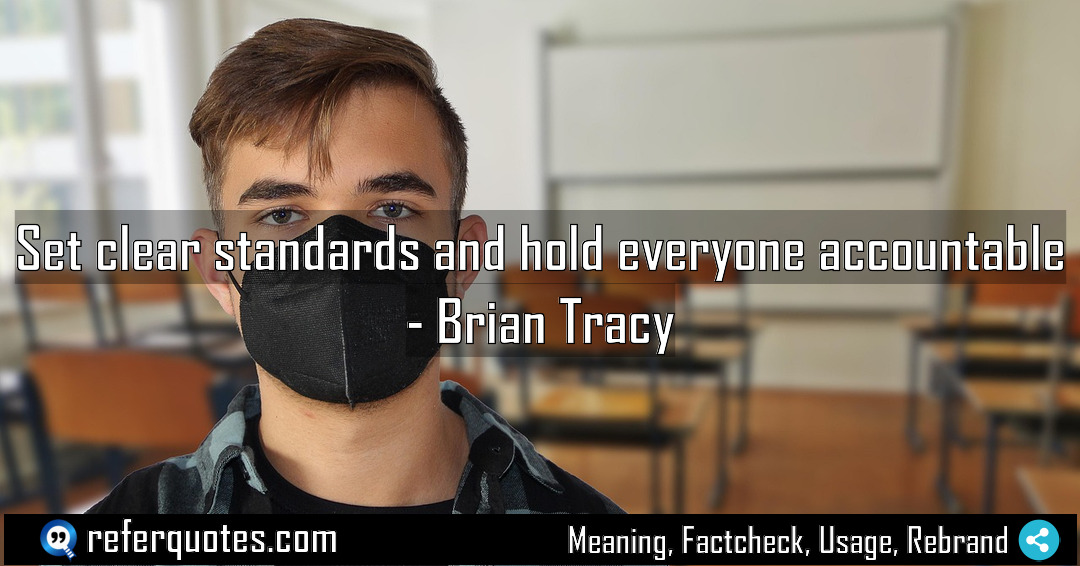
Set clear standards and hold everyone accountable is the secret sauce for building a high-performing team. It sounds simple, but it’s the foundation that separates chaotic workplaces from truly great ones. When you get this right, you eliminate ambiguity and create an environment where everyone can thrive and deliver their best work.
Share Image Quote:
Table of Contents
Meaning
It’s a two-part leadership principle: first, define the rules of the game clearly, and second, ensure everyone, without exception, plays by them.
Explanation
Look, I’ve seen so many managers get this wrong. They either set vague goals like “do better” or they enforce rules selectively, which just breeds resentment. The magic here is in the connection. Clear standards are useless if you don’t have the backbone to hold people to them. And holding people accountable is unfair and toxic if you haven’t first made the expectations crystal clear. It’s a complete system. When you do both, you build trust and create a culture of fairness and high performance. It’s about creating a level playing field where excellence is the only option.
Quote Summary
Reading Level55
Aesthetic Score76
Origin & Factcheck
This quote comes straight from Brian Tracy’s 2001 book, “Hire and Keep the Best People.” It’s a cornerstone of his philosophy on building a winning team. You might see similar sentiments floating around, but this specific phrasing is Tracy’s, rooted in his extensive work on business effectiveness and personal success.
Attribution Summary
Author Bio
Brian Tracy, a prolific author gained global reputation because of his best seller book list such as Eat That Frog!, Goals!, and The Psychology of Selling, and created influential audio programs like The Psychology of Achievement. He is sought after guru for personal development and business performance. Brian Tracy International, coaches millions of professionals and corporates on sales, goal setting, leadership, and productivity.
Official Website |Facebook | X | Instagram | YouTube |
Where is this quotation located?
| Quotation | Set clear standards and hold everyone accountable |
| Book Details | Publication Year/Date: 2001; ISBN: 978-1576751275; Last edition: 2001, Berrett-Koehler Publishers; Number of pages: 112. |
| Where is it? | Chapter: Standards and Accountability; Approximate page from 2001 edition |
Context
In the book, Tracy isn’t just talking about discipline. He’s positioning this as the fundamental strategy for attracting and, more importantly, retaining top-tier talent. High performers *want* this structure. They crave knowing exactly what is expected and seeing that the same rules apply to everyone, including leadership.
Usage Examples
This isn’t just corporate fluff. Here’s how it plays out in the real world:
- For a Team Leader: Instead of saying “Let’s improve customer service,” you set a clear standard: “Our target is to resolve 95% of customer inquiries within 24 hours.” Then, you hold the weekly meeting where you review the metrics with the entire team, celebrating those who hit it and coaching those who didn’t.
- For a Project Manager: You define the project milestones, quality benchmarks, and communication protocols from day one. When a senior team member misses a deadline, you have the same conversation you’d have with a junior member. That consistency is everything.
- For a Company Founder: You bake this into your core values. You publicly commit to transparency and ethical practices (the standard), and you make the tough decision to part ways with a high-revenue client who asks you to compromise those ethics (the accountability).
To whom it appeals?
Share This Quote Image & Motivate
Motivation Score84
Popularity Score80
Shareability Score83
FAQ
Question: Doesn’t this create a rigid, inflexible environment?
Answer: Actually, it’s the opposite. Clarity creates freedom. When people know the boundaries and the goals, they have the autonomy to be creative and find the best way to get there within that framework. Ambiguity is what truly paralyzes teams.
Question: What if someone consistently fails to meet the standards?
Answer: That’s where the “hold everyone accountable” part kicks in. Accountability isn’t just punishment. It starts with support and coaching. But if, after genuine support, someone still can’t meet the clear, fair standards, then you have a data-driven reason to make a change—which is also fair to the rest of the team who *are* meeting them.
Question: How do I get buy-in from my team on the standards?
Answer: Great question. Involve them in the process! Instead of dictating, collaborate on setting those standards. When people have a voice in creating the rules, they have a much greater stake in upholding them.
Similar Quotes
The way you treat yourself sets the standard… it’s a simple but profound truth. It’s less about ego and more about the invisible signals you broadcast to the world every…
Treat everyone as if they were the most important person in the world because that’s exactly how they see themselves. It’s a simple but profound shift in perspective that completely…
Be hard on the problem and soft on the people is a game-changing principle for anyone who has to collaborate. It’s about separating the issue from the individual, a skill…
The way you treat your employees… it’s not just an HR policy, it’s the cultural DNA of your entire company. I’ve seen it firsthand—how you handle your team ripples out…
When we fail to set boundaries and hold people accountable, we end up feeling completely drained and resentful. It’s a direct line from our own inaction to that feeling of…
